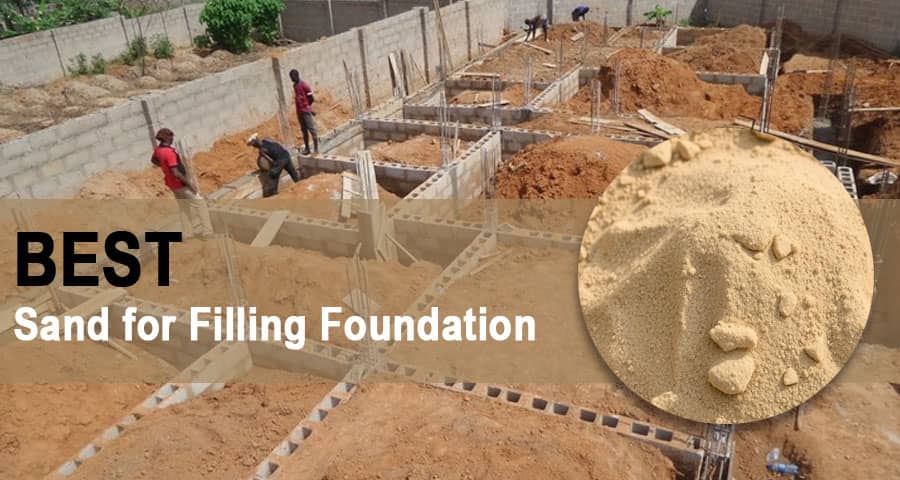What Is the Best Sand for Filling Foundation and Why?

When it comes to creating a strong and stable foundation, one of the most crucial components is the type of sand used for filling. The performance, longevity, and strength of a building's base rely heavily on this fundamental material. Selecting the best sand ensures minimal settlement, excellent compaction, and optimal load-bearing capacity.
Understanding the Role of Sand in Foundation Fill
Sand serves as a base and filler material during foundation construction. It facilitates:
- Drainage, preventing water accumulation
- Compaction, supporting the weight of the structure
- Even load distribution, reducing differential settlement
However, not all sands are equal. Factors such as grain size, moisture content, plasticity, and origin significantly influence their performance in foundation applications.
Types of Sand Commonly Used for Foundation Filling
1. Coarse Sand (Pit Sand or Sharp Sand)
Coarse sand, also known as pit sand, is considered one of the best types of sand for foundation filling due to its angular grains and superior drainage properties.
Key Benefits:
- Excellent load-bearing capacity
- Does not retain water, thus reducing the risk of swelling or shrinkage
- Easily compacted, enhancing structural stability
Why it's ideal: Its coarse texture ensures that it interlocks efficiently when compacted, reducing the voids and providing a firm foundation layer.
2. River Sand
River sand is a naturally occurring sand collected from riverbanks and beds. It is smooth, rounded, and contains silica-rich particles.
Advantages:
- Uniform granule size provides consistent compaction
- Adequate drainage capacity
- Naturally clean, often requiring less washing
Caution: While river sand is often used in construction, its rounded grains may not compact as tightly as coarse sand. For this reason, it's better suited for blending with other materials.
3. M-Sand (Manufactured Sand)
M-Sand is a crushed stone sand created by mechanical processes. It has gained popularity as a sustainable alternative to natural sand.
Notable Features:
- Angular shape supports better interlocking and compaction
- Less silt and organic impurities than river sand
- Consistent quality due to controlled production
Use in foundations: M-Sand is ideal for backfilling and foundation fill as it meets structural specifications, especially in areas where natural sand is scarce.
4. Fill Sand
Fill sand is a blend of fine particles, typically collected from quarries or dredging. It is often used when cost-effectiveness is a primary concern.
Uses:
- Filling voids and gaps
- Temporary fills
- Layer under slabs and pavement
However, because of its fine grain size and occasional clay content, it may not offer the same structural benefits as coarse or M-Sand.
Criteria for Choosing the Best Sand for Foundation Filling
To determine the most suitable sand, we must evaluate its geotechnical properties. Below are key criteria:
Grain Size and Gradation
- Well-graded sands (a mix of various particle sizes) compact better
- Uniform sands may lead to poor compaction and differential settlement
Moisture Content
- Sand should be slightly moist during compaction for best results
- Overly wet sand can become unstable

Cleanliness
- Sand should be free from clay, silt, salts, or organic matter
- Impurities can cause volume changes and chemical reactions with concrete
Compaction Behavior
- Sands with angular particles compact more effectively than rounded grains
- High compaction is essential for minimizing post-construction settlement
Why Coarse Sand Stands Out as the Best Choice
Among all options, coarse sand (pit sand) remains the top recommendation for most foundation filling applications. Here's why:
- Angular particles allow for excellent interlocking
- Delivers superior load distribution
- Reduces the chances of foundation shifting or cracking
- Offers optimal drainage, minimizing hydrostatic pressure
Its availability in many regions, coupled with its affordable cost and performance reliability, makes it the preferred choice of civil engineers and contractors alike.
Sand Compaction Techniques for Strong Foundation Filling
To ensure the sand performs optimally, proper compaction methods are essential. Common techniques include:
1. Mechanical Compaction
Using rollers, compactors, or rammers to press the sand into a dense layer.
2. Water Jetting
Water is used to help settle sand into voids in deep foundations.
3. Vibro-Compaction
Uses vibratory probes to rearrange the sand particles into a denser state.
4. Layer-wise Filling
Filling and compacting the sand in layers of 150mm to 200mm enhances structural performance.
Proper compaction not only improves strength but also ensures even load transfer across the foundation.
Common Mistakes to Avoid When Choosing Foundation Fill Sand
- Using untested or ungraded sand
- Neglecting compaction procedures
- Mixing sand with clayey soil
- Ignoring moisture content before filling
- Overlooking particle shape and size distribution
Avoiding these mistakes is critical for ensuring long-term durability and safety of the structure.
Conclusion: Coarse Sand is the Optimal Foundation Fill Material
After evaluating the types, properties, and performance metrics of various sands, coarse sand (pit sand) emerges as the best choice for foundation filling. Its high compaction ability, angular particles, and excellent drainage characteristics make it ideal for forming a strong and stable foundation. For projects where coarse sand is unavailable, M-Sand provides a high-performance, engineered alternative.
Choose your sand wisely, and always back your decision with proper geotechnical analysis and compaction procedures. The right choice today can save thousands in repair and maintenance costs tomorrow.
